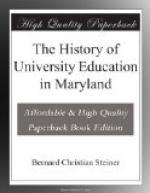Our results are much less satisfactory when we turn to the other side of our system, and enquire as to curriculum. It must be admitted that the larger part of our local centres can only take unit courses; there may be often a considerable interval between one course and another; or where courses are taken regularly the necessity of meeting popular interest involves a distracting variety of subjects; while an appreciable portion of our energies have to be taken up with preliminary half-courses, rather intended to illustrate the working of the movement than as possessing any high educational value. The most important advance from the unit course is the Affiliation system of Cambridge university. By this a town that becomes regularly affiliated, has arranged for it a series of unit courses, put together upon proper sequence of educational topics, and covering some three or four years: students satisfying the lecturers and examiners in this extended course are recognized as ‘Students affiliated’ (S.A.), and can at any time enter the university with the status of second year’s men,—the local work being accepted in place of one year’s residence and study. Apart from this, the steps in our educational ladder other than the first are still in the stage of prophecy. But it is universally recognized that this drawback is a matter solely of funds: once let the movement command endowment and the localities will certainly demand the wider curriculum that the universities are only too anxious to supply.
The third point in our definition was that the movement was to be organized on a basis of itinerant teachers. This differentiates University Extension from local colleges, from correspondence teaching, and from the systems of which Chautauqua is the type. The chief function of a university is to teach, and University Extension must stand or fall with its teachers. It may or may not be desirable on other grounds to multiply universities; but there is no necessity for it on grounds of popular education, the itinerancy being a sufficient means of bringing any university into touch with the people as a whole. And the adoption of such a system seems to be a natural step




